| Jun-15-05 | | Knight13: Good endgame play by White. He keeps the rook to support the pawns to go up the board with the King. These endgames are studiable! (Is studiable a word?) Good game. |
|
| Jun-15-05 | | arielbekarov: <Knight13> You are right that this game is excellent for studying the endgame. The games that I know of between these two giants in their fighting about the WorldChampion title
are very educative for all parts of the game. These games are like a testimony for us to benefit from. I couldn't find 'studyable' in my dictionnary, but let's make a word of it.
What about the spelling 'studyable'?
You agree?
Nevertheless, thank you for focusing on this great game
and good luck to you in your own chess-career!
Ariel |
|
| Jun-15-05 | | Knight13: <arielbekarov> I think studiable is better. But studyable is okay, too. And thanks for your comments. :) |
|
Oct-20-07
 | | keypusher: Here is the position after 55. Rd2 as given in Fine's Basic Chess Endings, diagram 362, p. 355:
click for larger viewThe simplest draw, according to Fine, was 55....Re3 (55....Rxd2+? loses immediately) 56. Rd4+ Kc5 57. Rd3 Re2+ 58. Rd2 Re3 59. Rf2 f4! 60. Kb2 Rg3 61. Ka3 Kb5 62. Kb2 Kc5! 63. Kd1 Rxb3 64. Rxf4 Rg3 65. Rf2 Kc5 66. Ke1 Kd6 67. Kf1 Ke7=. 55....Re4 56. Rf2 Rg4 57. Kb2 f4! 58. Kc2 Kc5! 59. Kd3 Rg3+ 60. Ke4 Rxb3 61. Kxf4 Kd6 62. Re2 Rb8 was also good enough to draw, but Steinitz's 57....Re4? was not: 58. g3! Re5 59. Rf4+ Kb5 60. Ka3 Rd5 61. Rf3 Ka5 62. b4+ Kb5 63. Kb3 Kc5 64. Kc4 Kc6 65. Rb3! Re5 66. b5+ Kb6 67. Kd4 Re4+ 68. Kd5 Re8 69. Kd6 Re1 70. Rf3 Kxb5 71. Rxf5+ Kc4 72. g4 and White won. |
|
Jan-05-08
 | | Chessical: Steinitz having won the previous two games perhaps saw this as his last chance in the match. He was prepared to play sharply and take his chances, hence the <11...c4> accepting the inherent weakening of his K-side, instead of castling but reducing the tension in the position. Lasker develops an initiative, but this suprisingly fades <41.Rd6+> seems very strong (using the combined threats of Nd8+ and e6+) 41...Rg6 42.b4 (the Rook has too few squares) 42...Rg4 (to stop a4) 43.a3 Bc8 (if 43...Rc4 then 44.Nd8+ wins the Bishop) 44.e6+ wins. Lasker seems to have have the endgame edge in this match, and in the ensuing endgame, Steinitz appears to have missed several opportunites to draw. <55...Re3> (R.Fine) seems a cast iron draw - e.g. 56.Rd4+ Kb5 57.Rd5+ Kb4 58.Rd3 Re2+ 59.Rd2 Re3=; but even after this Steinitz is not lost. <57...Rg5> 58.Rf4+ Kb5 59.Kc3 Rxg2 60.Rxf5+ Kc6=;
or;
<57...f4> 58.Kc2 (58.Rd2 Rg3 59.Rd4+ Kb5 60.Rxf4 Rxg2+ 61.Kc3 Rg3+ =) 58...Rh4 59.Kd3 Kxb3 60.Ke4 Rg4 61.Kf3 Rg8 62.Re2 Kc3 63.Re4 Rg3+ 64.Kf2 Rg4 65.Ra4 <63...f4> 64.gxf4 (64.g4 Rd4 65.g5 Rxb4+ 66.Kc2 Rc4+ 67.Kd3 Rc5 68.g6 Rg5 =) 64...Rd4 65.f5 Rxb4+ 66.Kc3 Ra4 67.Kb3 =. <70...Kxb5?> seems to be the tipping point past which only his opponent making a mistake could save Steinitz. <70...Re4+> would have probably lost eventually but would have been more inconvenient for Lasker. The end is: <78.Re7> Ra6+ 79. Re6 Ra5 80.g7 Rf5+ 81.Ke7 Rg5 82.Kf7 Kf5 83.Rf6+ Ke4 84.Rg6 |
|
Jan-05-08
 | | keypusher: In my note below I left out 63. Kc2 Kb5 and also got the page number wrong -- it's p. 335. <Chessical> 41. Rd6 does indeed look winning to me, though I haven't looked at it with an engine. In your line beginning with 57....f4 you diverge from Fine by capturing the pawn on b3 with the king rather than the rook, which seems counterintuitive. In your line, does 61. Kf5 (rather than 61. Kf3) 61....Rh4 62. Kg5 help White? 62...Rh2 63. Kxf4 Rh8(?) 64. g4 Rf8+(?) 65. Kg3 Rg8 66. Rd2 looks like a book win. But what if 64...Kc3? Then 65. g5 Kd4(?) 66. Rd2+ wins, and so, I think, does 65....Kd3 66. g6 and 65....Rg8 66. Re2. |
|
Jan-05-08
 | | keypusher: <chessical> 63....f4 is a neat idea. But can White play 64. gxf4 Rd4 65. f5 Rxb4+ 66. Kc2(!) Rc4+ 67. Kd3 Rc8 66. Kd4, when 66....Kc6 loses to 67. Rc3+? I thought Black might be able to draw by shifting the rook between e5 and d5, but 63....Re5 64. Kc3 Rd5 65. Rf4 Re5 66. Kd4! looks winning. |
|
Jan-05-08
 | | keypusher: <chessical> 70....Re4 isn't check, unless I have the board set up wrong. Is 71. Rxf5 Rg4 the idea? I think White can win after 72. Rf3 Kxb5 73. Ke5 Kc5 (73....Kc4? 74. Rf4+) 74. Kf5 Rg8 75. g4. |
|
Jan-05-08
 | | Chessical: <Keypusher> thank you very much for your detailed comments. Firstly, <70..Re4> is only a check due to a typo. I believe that Steinitz is completely lost at this point, and taking the pawn just loses. Actually, it does not really matter. True, Steinitz could use the Rook to harass Lasker, but his only real hope was for a rare nervous error by Lasker, and then perhaps a very lucky draw. Looking again, I have to admit that this would have been very unlikely, the winning technique being rudimentary for Lasker, for example: <70...Re4> 71.Rxf5 Rg4 72.Rf3 Rb4 (<72...Kxb5> 73.Ke5 Rg8 should be a White win once the White King gets ahead of his passed pawn and uses his Rook to seal the opposing King off along the <f> file) 73.Ke5 Rg4 74.Kf5 Rg8 75.g4 Rf8+ etc... I believe I am on firmer ground, however, in sytating that <63...f4> holds up as a defence, e.g. <64.gxf4> Rd4 65.f5 Rxb4+ <66.Kc2> (<keypusher>) <Kc5> 67.f6 (<67.Kd3> Rb3+ 68.Ke4 Rxf3 69.Kxf3 Kd6 is a draw) 67...Rb8 68.f7 Rf8 which is a draw Finally, in the line starting <57...f4> (Rather than 57....Re4 as Steinitz played) the Black Rook is on <h4> and cannot capture on <b3> - (my apologies if I have misunderstood you). |
|
Jan-05-08
 | | keypusher: <Chessical> You appear to be absolutely right that 63...f4 draws. What a nice defense! What I said <In your line beginning with 57....f4 you diverge from Fine by capturing the pawn on b3 with the king rather than the rook, which seems counterintuitive> was not clear at all. I was referring to the line in the second paragraph of my original post on this page, which I copied from Basic Chess Endings. The line begins <55....Re4 56. Rf2 Rg4 57. Kb2 f4! 58. Kc2> 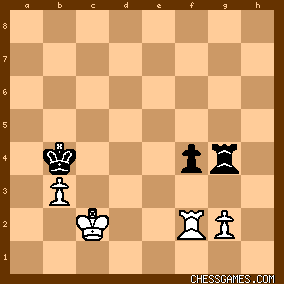
click for larger viewFine's analysis continues 58....Kc5 59. Kd3 Rg3+ 60. Ke4 Rxb3 61. Kxf4 Kd6 62. Re2 Rb8 with what looks like a book draw (because the black king is only two files away from the pawn). Your line continues <58...Rh4 59.Kd3 Kxb3 60.Ke4 Rg4 61.Kf3 Rg8 62.Re2 Kc3 63.Re4 Rg3+ 64.Kf2 Rg4 65.Ra4>so you capture the pawn at b3 with your king, while Fine uses the rook. I thought 61. Kf5 might be an improvement for White in your line. |
|
Jan-06-08
 | | Chessical: <Keypusher> I agree that Fine's analysis is the most accurate approach, <55....Re4> 56. Rf2 Rg4 57. Kb2 f4! 58. Kc2 <Kc5> 59. Kd3 Rg3+ 60. Ke4 Rxb3 61. Kxf4 Kd6 62. Re2 Rb8, and as you observe "with what looks like a book draw (because the black king is only two files away from the pawn)". Yet, from the above line, does a divergence at move 58 with <...Rh4> necessarily lose for Black? I think the position may still be defensible: <58...Rh4> 59.Kd3 Kxb3 60.Ke4 Rg4 <61.Kf5> (Keypusher) Rg8 62.Kxf4 Rf8+ 63.Kg3 Rg8+ 64.Kh2 Kc4 "A ,<b>/<g> pawn on the second wins if the enemy King is cut off by five files" Euwe and Hooper 'A Guide to Chess Endings',(Dover) p.147. Here we have only 4 files separation. <65.Rf4+> (<65.g3> Kd5 66.Rf4 Rh8+ 67.Kg2 Ke6 68.Kf3 Rb8 69.g4 Rb3+ =) 65...Kd5 66.g4 Ke6 67.Kg3 Rh8 68.g5 Ke7 69.Kg4 Rf8 70.Ra4 (<70.Rxf8?> Kxf8=) 70...Kf7 71.Ra7+ Kg6 72.Ra6+ Kg7 = |
|
Jan-13-08
 | | keypusher: <Chessical> Looks like you are right again, 61....Rg8 is a draw. Thanks, this has been very educational! |
|
| Jun-07-08 | | whiteshark: <Chessical: <Lasker develops an initiative, but this suprisingly fades
<41.Rd6+> seems very strong (using the combined threats of Nd8+ and e6+) 41...Rg6 42.b4 (the Rook has too few squares) 42...Rg4 (to stop a4) 43.a3 Bc8 (if 43...Rc4 then 44.Nd8+ wins the Bishop) 44.e6+ wins. >> I'm astounded how quick the black position collapses after <41.Rd6!! Rg6 42.b4!> 
click for larger view All white pieces work in harmony together, whereas the black pieces don't. |
|
| Aug-08-08 | | whiteshark: Chessnote # <3847. ‘Lasker’s greatest blunder’> is reporting about 2 different versions of white's 50th move (i.e. 50.Rd8/50.Rd1).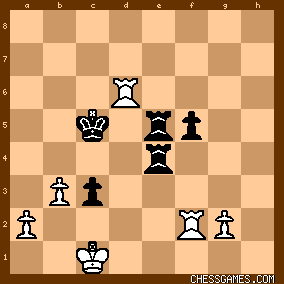
click for larger view
<50.Rd8> is it, of course! http://www.chesshistory.com/winter/... |
|
| Aug-08-08 | | Boomie: After 55...Re3, if white tries 56. Rf2 Rxb3 57. Rxf5 is a tablebase draw.
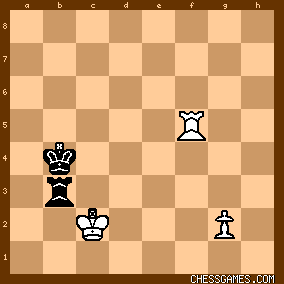
click for larger viewHowever after 56...Rxb3 white wins with 57.Rf4+ Ka3 58.Rxf5
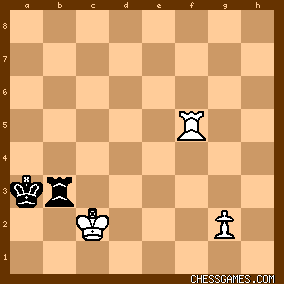
click for larger viewSo black can't take the pawn on b3 yet. He is saved by 56...Rc3+ 57.Kd1 Kxb3 (Rxb3 works, too)
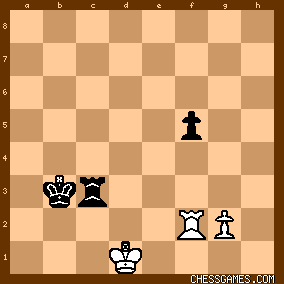
click for larger viewThis means 56.Rf2 doesn't work.
56.Rd4+ goes nowhere as black has Re2+ waiting. As the other rook moves lead down the same path, the position is a draw. |
|
Apr-25-20
 | | woldsmandriffield: A famous ending and a very sad outcome for Steinitz. After a terrible hammering he had won two games in succession (his first of the match) prior to this game. 
click for larger viewShould Black defend by cutting the White King off a rank or a file? Influenced by the presence of the f5 Pawn, Steinitz opted to cut the King off at the 5th rank and it proved a fatal error. Instead, 65..Rd8! held: 66 b5+ Kb6 67 Rd3 Rg8 68 Kd4 Kxb5! 69 Ke5 Kc4! 70 Rf3 Re8+ (!) 71 Kxf5 Rf8+ 72 Kg4 Rg8+ 73 Kh5 Kd5 
click for larger view74 Re3 Rh8+ 75 Kg6 Rg8+ 76 Kf7 Rg4 77 Kf6 Kd4! 78 Kf3 Ke4 = |
|
| Oct-26-20 | | nummerzwei: This is the position after Black's 56...Rg4:
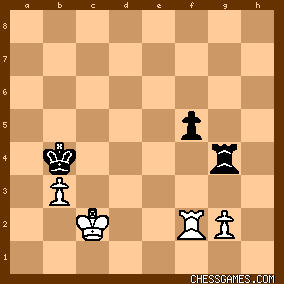
click for larger viewWhite cannot make progress if Black just keeps his rook on the g-file. In fact, the position is still drawn if you remove Black's pawn. |
|
| Oct-24-22 | | Ninas Husband: The most crucial game of this match. Lasker built up a 7-0 lead, but then Steinitz won games 12 and 13 to narrow it to 7-2. Still not exactly a nail-biter, but Lasker really needed to get off the schneid, and did he ever! Lots of tactical fireworks led to a pawn up endgame, which the champ converted with his usual flair. Lasker was always strong in the endgame, and this is a prime example. |
|
Oct-25-22
 | | LIFE Master AJ: Didn't use an engine.
Long game. (Seen it before.)
Lasker's technique was nearly flawless. |
|
Oct-25-22
 | | LIFE Master AJ: I once had a similar position. My opponents King got overly brave, advanced to a3 ...
and was mated. |
|
Apr-13-23
 | | NM JRousselle: Steinitz could have easily drawn had he found 63... f4! |
|





































